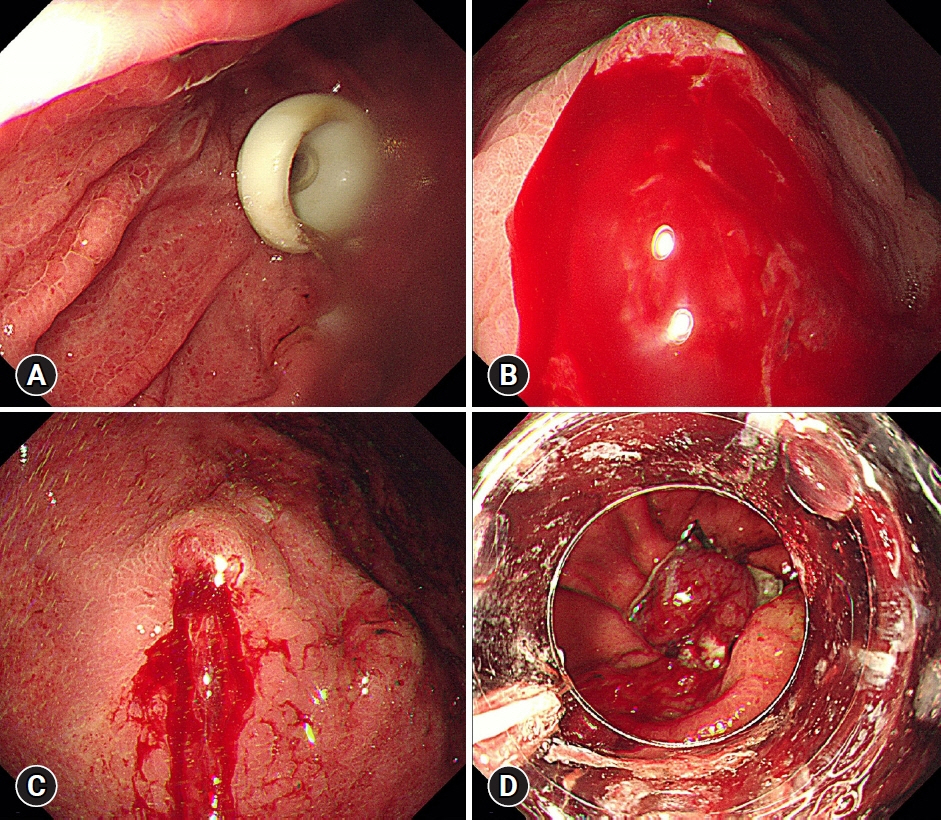Clin Endosc.
2022 May;55(3):443-446. 10.5946/ce.2020.294.
Endoscopic hemostasis using an over-the-scope clip for massive bleeding after percutaneous endoscopic gastrostomy removal: a case report
- Affiliations
-
- 1Department of Internal Medicine, Kyungpook National University School of Medicine, Daegu, Korea
- 2Department of Internal Medicine, Kyungpook National University Hospital, Daegu, Korea
- KMID: 2529967
- DOI: http://doi.org/10.5946/ce.2020.294
Abstract
- Percutaneous endoscopic gastrostomy (PEG) is a common method for providing long-term enteral nutrition to patients. PEG tube placement and removal are relatively safe; generally, a PEG tube can be removed using gentle traction, and excessive bleeding is rare. The over-the-scope clip system is a new device that can be used for gastrointestinal hemostasis and for closing gastrointestinal fistulae. In the present case, a 68-year-old male patient had to remove the PEG tube because of persistent leakage around the PEG tube. Although it was gently removed using traction, incessant bleeding continued, with a Rockall score of 5 points, even after hemocoagulation was attempted. An over-the-scope clip device was used to achieve hemostasis and fistula closure.
Figure
Reference
-
1. Deitch EA, Winterton J, Li M, et al. The gut as a portal of entry for bacteremia. Role of protein malnutrition. Ann Surg. 1987; 205:681–692.2. Gauderer MW, Ponsky JL, Izant RJ. Gastrostomy without laparotomy: a percutaneous endoscopic technique. J Pediatr Surg. 1980; 15:872–875.3. Sheehan JJ, Hill AD, Fanning NP, et al. Percutaneous endoscopic gastrostomy: 5 years of clinical experience on 238 patients. Ir Med J. 2003; 96:265–267.4. Prosser B. Common issues in PEG tubes: what every fellow should know. Gastrointest Endosc. 2006; 64:970–972.5. Kim JK, Kim YK, Lee YR, et al. A case of massive bleeding after peg removal by traction method. Korean J Gastrointest Endosc. 1999; 19(Suppl 2):33S–37S.6. Heinrich H, Gubler C, Valli PV. Over-the-scope-clip closure of long lasting gastrocutaneous fistula after percutaneous endoscopic gastrostomy tube removal in immunocompromised patients: a single center case series. World J Gastrointest Endosc. 2017; 9:85–90.7. Dişibeyaz S, Köksal A, Parlak E, et al. Endoscopic closure of gastrointestinal defects with an over-the-scope clip device: a case series and review of the literature. Clin Res Hepatol Gastroenterol. 2012; 36:614–621.8. Singhal S, Changela K, Culliford A, et al. Endoscopic closure of persistent gastrocutaneous fistulae, after percutaneous endoscopic gastrostomy (PEG) tube placement, using the over-the-scope-clip system. Therap Adv Gastroenterol. 2015; 8:182–188.9. Wedi E, Fischer A, Hochberger J, et al. Multicenter evaluation of first-line endoscopic treatment with the OTSC in acute non-variceal upper gastrointestinal bleeding and comparison with the Rockall cohort: the FLETRock study. Surg Endosc. 2018; 32:307–314.10. Schmidt A, Gölder S, Goetz M, et al. Over-the-scope clips are more effective than standard endoscopic therapy for patients with recurrent bleeding of peptic ulcers. Gastroenterology. 2018; 155:674–686.e676.11. Sulz MC, Bertolini R, Frei R, et al. Multipurpose use of the over-the-scope-clip system (“Bear claw”) in the gastrointestinal tract: Swiss experience in a tertiary center. World J Gastroenterol. 2014; 20:16287–16292.12. Kobara H, Mori H, Nishiyama N, et al. Over-the-scope clip system: a review of 1517 cases over 9 years. J Gastroenterol Hepatol. 2019; 34:22–30.13. Kirschniak A, Subotova N, Zieker D, et al. The over-the-scope clip (OTSC) for the treatment of gastrointestinal bleeding, perforations, and fistulas. Surg Endosc. 2011; 25:2901–2905.
- Full Text Links
- Actions
-
Cited
- CITED
-
- Close
- Share
- Similar articles
-
- Endoscopic Management of Gastrointestinal Leaks and Bleeding with the Over-the-Scope Clip: A Prospective Study
- New endoscopic techniques in treating gastrointestinal bleeding
- Endoscopic Management with a Novel Over-The-Scope Padlock Clip System
- Recent Developments in the Endoscopic Treatment of Patients with Peptic Ulcer Bleeding
- Massive Gastric Bleeding Occuring after the Replacement of Percutaneous Endoscopic Gastrostomy Tube


